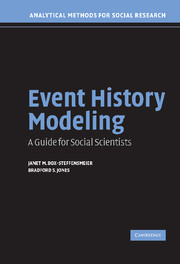Book contents
- Frontmatter
- Contents
- List of Figures
- List of Tables
- Preface
- 1 Event History and Social Science
- 2 The Logic of Event History Analysis
- 3 Parametric Models for Single-Spell Duration Data
- 4 The Cox Proportional Hazards Model
- 5 Models for Discrete Data
- 6 Issues in Model Selection
- 7 Inclusion of Time-Varying Covariates
- 8 Diagnostic Methods for the Event History Model
- 9 Some Modeling Strategies for Unobserved Heterogeneity
- 10 Models for Multiple Events
- 11 The Social Sciences and Event History
- Appendix: Software for Event History Analysis
- References
- Index
8 - Diagnostic Methods for the Event History Model
Published online by Cambridge University Press: 05 September 2012
- Frontmatter
- Contents
- List of Figures
- List of Tables
- Preface
- 1 Event History and Social Science
- 2 The Logic of Event History Analysis
- 3 Parametric Models for Single-Spell Duration Data
- 4 The Cox Proportional Hazards Model
- 5 Models for Discrete Data
- 6 Issues in Model Selection
- 7 Inclusion of Time-Varying Covariates
- 8 Diagnostic Methods for the Event History Model
- 9 Some Modeling Strategies for Unobserved Heterogeneity
- 10 Models for Multiple Events
- 11 The Social Sciences and Event History
- Appendix: Software for Event History Analysis
- References
- Index
Summary
In this chapter, we consider some important issues regarding model selection, assessment, and diagnostic methods through the use of residuals. The issues discussed in this chapter have a direct analog to methods of model selection and to model diagnostics in the context of the traditional linear model. For example, issues pertaining to functional form, influential observations, and similar other topics are directly relevant to the duration model. Because most of the methods of specification analysis discussed in this chapter make use of residuals, in the next section, we consider the different kinds of residuals that are retrievable from a typical duration model. Following this, we present several illustrations using residual analysis to assess various facets of the duration model. Most of the discussion in this chapter is presented in terms of the Cox model; however, diagnostic methods for parametric models are considered at the end of the chapter.
Residuals in Event History Models
The basic idea of a residual is to compare predicted and observed durations. In OLS regression, residuals are deviations of the observed values of the dependent variable from the values estimated or predicted value under the regression model, that is yi – ŷi. In event history analysis, defining a residual is more difficult because of censoring and because of issues relevant to estimation methods like maximum likelihood (in the case of parametric models) or maximum partial likelihood (in the case of the Cox model).
- Type
- Chapter
- Information
- Event History ModelingA Guide for Social Scientists, pp. 119 - 140Publisher: Cambridge University PressPrint publication year: 2004



